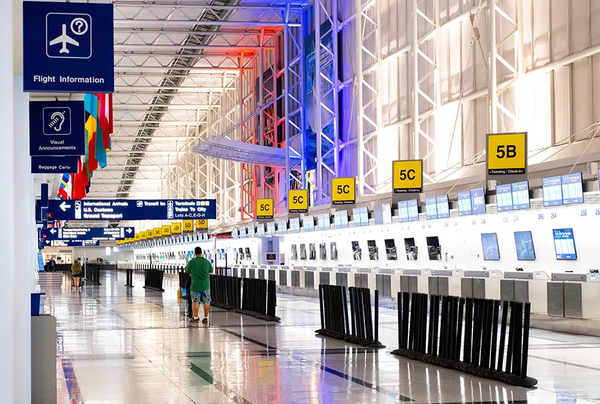There’s a good chance you’ve been on an aircraft struck by lightning. After all, lightning will strike planes 1-4 times annually. Maybe you saw a flash, or perhaps you heard loud noises. Or maybe you felt and saw nothing at all. Rest assured, though, that nothing serious should happen when lightning strikes a plane because of how well-engineered aircraft are to deal with strikes. Let’s dive into what exactly happens.

To begin with, aircraft bodies are heavily conductive and ionize quickly. When there is a significant increase in the electromagnetic field density, commonly observed in thunderstorms, ionization occurs. In particular, the ionization occurs on the edges of the fuselage, like the cockpit or wingtips, which tend to be sharper. The ionization may extend off the tips, trying to attract the energy found in the charged clouds in the thunderstorm.
Lightning occurs when the charged ionized air emanating off of the aircraft joins with charged, ionized air in the cloud. Most often, the plane is trapped in between the strike. At this point, lightning currents travel along the aircraft and exit to the ground or back into the sky. Normally, the current leaves at another extremity, such as the tail. Aircraft are also at a high risk of being caught in a strike at airports. They are equally likely to ionize and pose a major threat to individuals on the ground working near the aircraft.

Because aircraft bodies are very conductive, passengers have little to fear. The current simply does not leave the body and enter more critical areas. According to Boeing, the metal surface on most of their non-composite, older aircraft is sufficient to protect the airplane’s internal spaces from a lightning strike. The metal body also prevents electromagnetic energy from entering the aircraft’s electrical circuit. Essentially, it acts as a Faraday Cage that prevents electromagnetic currents from being altered significantly.
Most electrical components are unharmed for non-significant strikes, although they require maintenance and careful observation from engineers. For significant strikes, the electromagnetic energy may overpower the metal protection and minimally damage electrical components. In this case, flights with the aircraft tend to face extensive delays.

It follows that airlines and aircraft manufacturers take lightning protection very seriously. Nearly every airline has a lightning engineer to ensure that following every lightning strike, the fuselage, and electrical components are unharmed and well-protected to remain operational after the next strike. The last lightning-induced commercial aircraft crash was in 1967—a testament to the engineering brilliance of modern-day aircraft.
The Top 5 Longest Flights in the World » GTF Storage Crisis Deepens: 835 Aircraft Grounded as Pratt & Whitney Recalls Surge Post-Mid-Year » GlobalX Secures Rare Authorisation to Operate Intra-Canada Charter Flights »
Comments (0)
Add Your Comment
SHARE
TAGS
INFORMATIONAL Lightning Engineering Safety Weather ClimateRECENTLY PUBLISHED
 What You Don't Know About Airport Operations That Go Overnight
Airports are like noisy cities. A dedicated team ensures everything works properly, even on the final flight of the night. Clean the aircraft, solve mechanical issues, and prepare for a busy day.
NEWS
READ MORE »
What You Don't Know About Airport Operations That Go Overnight
Airports are like noisy cities. A dedicated team ensures everything works properly, even on the final flight of the night. Clean the aircraft, solve mechanical issues, and prepare for a busy day.
NEWS
READ MORE »
 GlobalX Secures Rare Authorisation to Operate Intra-Canada Charter Flights
Global Crossing Airlines Group, Inc. (GlobalX) has achieved a significant regulatory milestone in its northern expansion strategy. The Canadian Transportation Agency (CTA) has officially granted the Miami-based operator authorisation to conduct intra-Canada charter flights, a permission rarely extended to U.S. carriers.
NEWS
READ MORE »
GlobalX Secures Rare Authorisation to Operate Intra-Canada Charter Flights
Global Crossing Airlines Group, Inc. (GlobalX) has achieved a significant regulatory milestone in its northern expansion strategy. The Canadian Transportation Agency (CTA) has officially granted the Miami-based operator authorisation to conduct intra-Canada charter flights, a permission rarely extended to U.S. carriers.
NEWS
READ MORE »
 GTF Storage Crisis Deepens: 835 Aircraft Grounded as Pratt & Whitney Recalls Surge Post-Mid-Year
The operational crisis surrounding the Pratt & Whitney Geared Turbofan (GTF) engine family has reached a new peak. As of late Q4 2025, the number of stored jets powered by the PW1000G family has climbed significantly, highlighting a widening gap between maintenance capacity and the relentless pace of engine recalls.
INFORMATIONAL
READ MORE »
GTF Storage Crisis Deepens: 835 Aircraft Grounded as Pratt & Whitney Recalls Surge Post-Mid-Year
The operational crisis surrounding the Pratt & Whitney Geared Turbofan (GTF) engine family has reached a new peak. As of late Q4 2025, the number of stored jets powered by the PW1000G family has climbed significantly, highlighting a widening gap between maintenance capacity and the relentless pace of engine recalls.
INFORMATIONAL
READ MORE »



